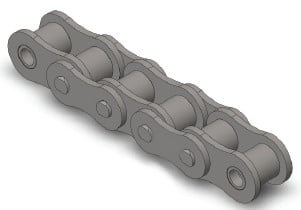Roller chains are one from the most efficient and cost eff ective tips on how to transmit mechanical power amongst shafts. They operate over a broad range of speeds, handle big working loads, have quite small vitality losses and are typically inexpensive in contrast with other strategies
of transmitting power. Productive variety entails following a number of relatively uncomplicated actions involving algebraic calculation plus the utilization of horsepower and service component tables.
For any provided set of drive conditions, there are a variety of feasible chain/sprocket confi gurations that may successfully operate. The designer as a result needs to be mindful of a number of primary assortment concepts that when applied correctly, aid stability total drive effectiveness and cost.  By following the steps outlined within this part designers ought to be capable to make choices that meet the necessities in the drive and therefore are expense eff ective.
By following the steps outlined within this part designers ought to be capable to make choices that meet the necessities in the drive and therefore are expense eff ective.
Basic Roller Chain Drive Rules
? The suggested number of teeth for your compact sprocket is 15. The minimum is 9 teeth – smoother operation is obtained with more teeth.
? The advised highest variety of teeth for your significant sprocket is 120. Note that whilst more teeth lets for smoother operation possessing as well lots of teeth leads to chain jumping off the sprocket right after a somewhat compact quantity of chain elongation on account of put on – That is chains by using a very large variety of teeth accommodate less put on prior to the chain will no longer wrap close to them thoroughly.
? Speed ratios needs to be seven:1 or significantly less (optimum) rather than greater
than ten:1. For more substantial ratios using multiple chain reductions is recommended.
? The encouraged minimum wrap of your small sprocket is 120°.
? The advisable center distance among shafts is 30-50 pitches of chain. There are actually two exceptions to this as follows:
1. The center distance have to be greater than the sum from the outside diameters with the driver and driven sprockets to avoid interference.
two. For velocity ratios better than 3:one the center distance shouldn’t be less than the outside diameter with the significant sprocket minus the outdoors diameter with the little sprocket to assure a minimal 120° wrap close to the small sprocket.
